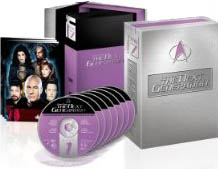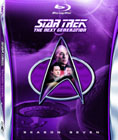Gambit
This story has always ranked quite highly with me amongst all of TNG's two-part stories.
It is quite simply a darned good adventure, chock full of scenes with good entertainment value,
and it has an ending that ticks the boxes of being logical, exciting, and celebrating
a healthy philosophical message that neatly makes its point. This is really the first story
to truly give season seven the big shot in the arm that it has been needing up to this point.
Part I... (Raiders of the Lost Picard)
Perhaps this story is less celebrated than it deserves because its weakest scenes
are up front at the beginning - and the scenes are decent actually, but far from
being great attention-grabbers that tell you this is a must-see show.
In their blatant low-budget imitation of Star Wars' infamous alien cantina scene,
we suffer through some icky smarmy innuendo as Troi and a bartender chat each other up,
just to get the point that Picard is missing and his crew are searching for him.
Riker and Worf fare a bit better with a rodent-looking alien, as they and Dr. Crusher
get to play some entertainingly different dynamics.
Ultimately, the news that Picard was vaporized was never destined to be believed
by the audience, who have seen Patrick Stewart appear in the trailers, but not yet in
the episode. We all know he'll show up soon enough, so our investment in the characters'
beliefs is limited. This section is all about whether or not those characters get
something worthy to do while thinking that Picard is no more. There's an unfortunate
brief repeat of something that the last story "Interface" did way too much of:
crewmembers pushing each other to wallow in grief prematurely. I'm not convinced
that the best way to get a catharsis from grief is to indulge in grief more strongly,
or that the writers don't have some bizarre fixation with returning to it too often.
Discernment, investigation, and action would (quite obviously in this case) be healthier
and lead to a happier truth. I'd say Riker and Troi's shouting match took things too far,
while the other portions of their scene were more worthwhile. And,
unlike the overdose of this that we got in "Interface", this section is thankfully short.
That said, I like the rest of Riker's quest to find the truth, his interaction with
the Starfleet admiral and the rodent alien. It's also great to get a hefty action
sequence early on - one more successful than anything in "Descent Part II" -
and great again that this key action sequence is set out on location. Thus,
this first half of episode one still fares quite well, while the rest of the story
builds in strength.
Picard is revealed operating under a false name as part of a crew of rogues and mercenaries,
as Riker is forced into their ranks as well. The irremovable pain devices reinforcing
the hostile command structure are far more entertaining here than anything back in the
previous year's "Chain of Command" story, largely because "Chain of Command" set its
dynamic between Picard and David Warner's character in a very clinical single room
far detached from any of the stakes on the Cardassian political front. Here, "Gambit"
is free to flip between the duress of the command structure and genuine co-operation
to achieve the group's goals, be they about the survival of their ship, or the
acquisition of mysterious objects that intrigue everyone for various reasons.
A much richer and more satisfying palette.
Personally, I really loved the fact that we had here a really good story for
Captain Picard, in which he got to exercise his passion for archaeology over
not just one but two linked episodes, and engage in a good, exciting,
"Indiana Jones" style adventure, and play out a lot of situations and types
of scenes that he wouldn't normally get.
"Gambit" has also done a pretty good and organic job of getting both Picard and Riker
off the ship in order to leave Data in command - this is MUCH, MUCH better than
the head-scratching tactics in "Descent". Plus, the move gives Data and Worf
some dynamics to play out between them that they don't normally get, and these dynamics
are very interesting, organic, and believable. Dr. Crusher and her chorus of extras
in "Descent" cannot begin to compete.
Gambit additionally had some very good guest cast members. Richard Lynch is a fine
actor who had pretty much played a guest villain on every American TV show of the
1970's and 1980's. His appearance here is no surprise, and satisfies again as usual.
Perhaps more unusual is the appearance of actress Robin Curtis, best known to
Star Trek fans as Lt. Saavik from the third and fourth feature films, and now playing
a much more antagonistic, assertive, and mysterious character. She does quite
well with the expanded role she plays here.
Nicely, the model-makers went to the trouble of giving the mercenaries a very
unique, detailed, and menacing spacecraft, which sees its share of action
throughout the two episodes. The cliffhanger is pretty good here, with the
danger of a ship-to-ship battle holding on a freeze-frame, as we wonder
exactly how far either Riker or Data will go in escalating the battle further.
Though it's not got the same suspense-factor that "The Best of Both Worlds" had,
it echoes the same flavour to good effect.
Part II... (Indiana Jean-Luc and the Weapon of Fear)
Much of part two continues in the same good vein as the latter half of the
first episode, only we are able to dig a little deeper into the mysteries,
and really enjoy Picard and Riker's interactions with the rest of the mercenary crew.
The guest characters have a little extra time to be developed in this story,
and it works fairly well for them. Plus, Stewart and Frakes seem to relish
the chance to do different and surprising things with each other,
and chew the scenery much more than usual. Entertaining stuff.
I admit I really get pulled into this story the more it digs into ancient
Romulan colonial history and Vulcan lore - I just want to learn more and more.
The character mystery and unpredictable interpersonal dynamics add to this
like icing on a cake. These sections work like a charm for me.
Admittedly, we don't get to see too many fresh locations in later sections
of the story. In that sense, the bar scenes and forest location sequences from
early part one were important in building viewer impressions of a quest with many
varied stops along the way... and the memory of these places in the viewers' minds
can then help make up for a Starbase represented by one dude on a viewing screen
whom no one visits. The design budget quite rightly focused on the interiors
of the mercenary ship, which are used heavily throughout, with a particularly impressive
and functional bridge.
I do enjoy the decidedly low-energy Klingon encountered by the Enterprise crew -
obviously someone accustomed to spending a lot of time by himself in space.
A lot of unique choices occur with that character, and it gives Dr. Crusher
and Worf and Data some fun scenes to play.
But perhaps the best bit here is the tension between Data and Worf - a very unique
dynamic that cannot be found in any other episode. It is so organic and believable
in both the way that it bubbles up to the surface and in how it resolves itself,
I think it's a real testament to the abilities of the Next Generation cast and the
degree to which they gelled over time. Compare all this to the very similar
problems Data was supposed to be having back in
"Redemption, Part II" (the season five opener),
and I think it's quite easy to see how superior "Gambit" is in portraying this.
Additionally, I think the writing for Worf here really achieves a nice balance between
some of his natural emotional tendencies and his abilities to quickly overcome
those tendencies to align himself with purer states of mind... when he decides it's worth it.
It's particularly great to get this in the middle of episode two here,
because it then lends great credibility later on when Worf is but
the second crewmember to be pure enough to pass the final weapon's big test.
Before the big wrap up for this story, we get a smaller one dealing with Richard Lynch's
character and his pain discipline device. The dynamic isn't bad, except for one outstanding
problem. Exactly when and how did Picard have a chance to do what he says he did?
It seemed that would have been the crux of the entire challenge - the kind of thing that
keeps every member of this crew awake at night trying to figure out. If he had cracked it,
we the audience deserve to find out how he managed it, and we can cry foul of the story
for cheating us. Shades of Doctor Who's
"The Stones of Blood" (story no. 100).
However, there is a brand new set in which the real final moments of this story
play out. Here, we can see that it is Picard's cleverness in reading and deciphering
all the clues presented to him so far, plus adding on top his general awareness of
social issues and how various cultures interpret them, that allows him to see the solution.
Interestingly, before he himself is seen to pass the test which many of his mercenary
shipmates fail, he winds up quickly coaching his rescue party from the Enterprise first.
By the time the test actually comes to Picard himself, it's a bit old hat, but still
satisfying. Both Patrick Stewart and Robin Curtis make some interesting choices
with their emotions, which actually carry the plot at this point. Their acting
is a good match to the philosophical point being made here, and it's a worthy one.
One of my favourites, in fact. It reminds me of one of the key background dynamics
of "Encounter at Farpoint", except it is much more succinct here, and embraces the
characters better. It also reminds me quite a bit of Doctor Who's
"Snakedance" (story no. 125), except here we are without
quite as detailed a cultural and philosophical build up.
Finally, we end with a fun coda sequence that ties up some of the remaining questions
and details of the adventure, while being quite big on humour. Great.
In the end, "Gambit" may not have seemed like a great story at first, but it delivers
well in giving us the kind of adventure story that made the original 1960's Star Trek
a hit, while managing a breezy tone for the most part, injected with a bit of mystery
and mythology and philosophical triumph. There's a lot to like here. When counting
up TNG's two-part stories and picking our favourites, this is one to remember,
particularly in how it achieved many worthy elements in a much more polished manner
than its predecessors, and for being a nicely rounded and full narrative in the end.
It's two enthusiastic thumbs up from me on this one,
easily the best season seven story so far....
|
|








 (regular)
(regular)



